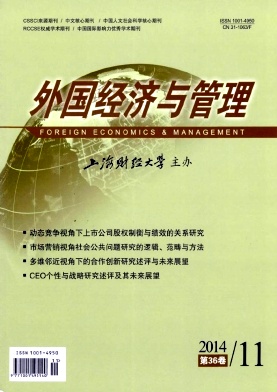动态竞争视角下上市公司股权制衡与绩效的关系研究
外国经济与管理 2014 年 第 36 卷第 11 期, 页码:3 - 11
摘要
参考文献
摘要
本文从动态竞争视角探索股权制衡对企业绩效的作用路径,在模型中加入企业防御能力变量,以解释股权制衡对企业绩效的影响机理。利用231家高科技民营上市公司2008—2012年的面板数据,本文对股权制衡、企业防御能力与绩效间的关系进行实证分析,得出如下结论:股权制衡有利于提升企业在动态竞争中的防御能力;股权制衡度对企业绩效存在正向影响;股权制衡度对企业绩效的正向影响是通过提高企业防御能力实现的。本文同时探讨了企业经营风险倾向在防御能力与企业绩效关系中的调节作用,结果表明:企业风险倾向越高,防御能力对企业绩效的促进作用越强。
[1]Bennedsen M and Wolfenzon D.The balance of power in closely held corporations[J].Journal of financial economics,2000,58(1):113-139.
[2]Chen M J,et al.Competitive tension:The awareness-motivation-capability perspective[J].Academy of Management Journal,2007,50(1):101-118.
[3]Chen M J and MacMillan I C.Nonresponse and delayed response to competitive moves:The roles of competitor dependence and action irreversibility[J].Academy of Management Journal,1992,35(3):539-570.
[4]Cheng S.Board size and the variability of corporate performance[J].Journal of Financial Economics,2008,87(1):157-176.
[5]Faccio M and Lang L H P.The ultimate ownership of Western European corporations[J].Journal of financial economics,2002,65(3):365-395.
[6]Grove H,et al.Corporate governance and performance in the wake of the financial crisis:Evidence from US commercial banks[J].Corporate Governance:An International Review,2011,19(5):418-436.
[7]Konijn S J J,et al.Blockholder dispersion and firm value[J].Journal of Corporate Finance,2011,17(5):1330-1339.
[8]Peng M W.Outside directors and firm performance during institutional transitions[J].Strategic Management Journal,2004,25(5):453-471.
[9]Porta R,et al.Corporate ownership around the world[J].The journal of finance,1999,54(2):471-517.
[10]Lin Y F.Corporate governance,leadership structure and CEO compensation:Evidence from Taiwan[J].Corporate Governance:An International Review,2005,13(6):824-835.
[11]Maury B and Pajuste A.Multiple large shareholders and firm value[J].Journal of Banking&Finance,2005,29(7):1813-1834.
[12]Shleifer A and Wolfenzon D.Investor protection and equity markets[J].Journal of Financial Economics,2002,66(1):3-27.
[13]Sitkin S B and Weingart L R.Determinants of risky decision-making behavior:A test of the mediating role of risk perceptions and propensity[J].Academy of management Journal,1995,38(6):1573-1592.
[14]Vaona A and Pianta M.Firm size and innovation in European manufacturing[J].Small Business Economics,2008,30(3):283-299.
[15]曾进.公司治理对企业风险—回报的影响——来自中国上市公司的经验证据[J].管理评论,2010,(7):46-52.
[16]陈德萍,陈永圣.股权集中度、股权制衡度与公司绩效关系研究——2007-2009年中小企业板块的实证检验[J].会计研究,2011,(1):38-43.
[17]陈文婷,李新春.上市家族企业股权集中度与风险倾向、市场价值研究——基于市场化程度分组的实证[J].中国工业经济,2008,(10):139-149.
[18]初旭,周杰.董事会治理对文化创意型上市公司经营绩效的影响研究[J].科学学与科学技术管理,2013,34(5):126-133.
[19]冯桂平.竞争互动行为的影响因素及影响机制研究[J].管理学报,2010,(12):1773-1778.
[20]郭海,李垣.治理机制、管理创新能力与自主创新关系研究[J].科学学研究,2007,24(6):962-966.
[21]贺勇,刘冬荣.融资约束、企业集团内部资金支持与R&D投入——来自民营高科技上市公司的经验证据[J].科学学研究,2011,29(11):1685-1695.
[22]黄志忠.基于资源配置的公司治理策略分析——以2006~2010年上市的公司为例[J].会计研究,2012,(1):36-42.
[23]李琳等.基于公司业绩波动性的股权制衡治理效应研究[J].管理世界,2009,(5):145-151.
[24]廖理等.经营风险、晋升激励与公司绩效[J].中国工业经济,2009,(8):119-130.
[25]孙兆斌.股权集中、股权制衡与上市公司的技术效率[J].管理世界,2006,(7):115-124.
[26]佟岩,陈莎莎.生命周期视角下的股权制衡与企业价值[J].南开管理评论,2010,13(1):108-115.
[27]王跃堂等.董事会的独立性是否影响公司绩效[J].经济研究,2006,(5):62-73.
[28]夏纪军,张晏.控制权与激励的冲突——兼对股权激励有效性的实证分析[J].经济研究,2008,(3):87-98.
[29]徐鹏,徐向艺.子公司动态竞争能力维度建构与培育机制——基于集团内部资本配置的视角[J].中国工业经济,2013,(5):109-121.
[30]徐鹏等.母公司持股、子公司管理层权力与创新行为关系研究——来自我国高科技上市公司的经验数据[J].经济管理,2014,(4):41-50.
[31]游春.股权激励、董事会、TMT团队与经营绩效——基于中国上市公司的实证分析[J].管理评论,2010(9):3-13.
[32]袁斌.动态竞争的战略主题及核心能力的提升路径[J].中国管理科学,2004,12(2):112-117.
[33]张其秀等.研发投入与公司绩效:股权制衡还是股权集中?——基于国有上市公司的实证研究[J].科学学与科学技术管理,2012,33(7):126-132.
[34]朱滔.大股东控制、股权制衡与公司绩效[J].管理科学,2007,10(5):14-21.
[35]祝继高,王春飞.大股东能有效控制管理层吗?——基于国美电器控制权争夺的案例研究[J].管理世界,2012,(4):138-152.
[2]Chen M J,et al.Competitive tension:The awareness-motivation-capability perspective[J].Academy of Management Journal,2007,50(1):101-118.
[3]Chen M J and MacMillan I C.Nonresponse and delayed response to competitive moves:The roles of competitor dependence and action irreversibility[J].Academy of Management Journal,1992,35(3):539-570.
[4]Cheng S.Board size and the variability of corporate performance[J].Journal of Financial Economics,2008,87(1):157-176.
[5]Faccio M and Lang L H P.The ultimate ownership of Western European corporations[J].Journal of financial economics,2002,65(3):365-395.
[6]Grove H,et al.Corporate governance and performance in the wake of the financial crisis:Evidence from US commercial banks[J].Corporate Governance:An International Review,2011,19(5):418-436.
[7]Konijn S J J,et al.Blockholder dispersion and firm value[J].Journal of Corporate Finance,2011,17(5):1330-1339.
[8]Peng M W.Outside directors and firm performance during institutional transitions[J].Strategic Management Journal,2004,25(5):453-471.
[9]Porta R,et al.Corporate ownership around the world[J].The journal of finance,1999,54(2):471-517.
[10]Lin Y F.Corporate governance,leadership structure and CEO compensation:Evidence from Taiwan[J].Corporate Governance:An International Review,2005,13(6):824-835.
[11]Maury B and Pajuste A.Multiple large shareholders and firm value[J].Journal of Banking&Finance,2005,29(7):1813-1834.
[12]Shleifer A and Wolfenzon D.Investor protection and equity markets[J].Journal of Financial Economics,2002,66(1):3-27.
[13]Sitkin S B and Weingart L R.Determinants of risky decision-making behavior:A test of the mediating role of risk perceptions and propensity[J].Academy of management Journal,1995,38(6):1573-1592.
[14]Vaona A and Pianta M.Firm size and innovation in European manufacturing[J].Small Business Economics,2008,30(3):283-299.
[15]曾进.公司治理对企业风险—回报的影响——来自中国上市公司的经验证据[J].管理评论,2010,(7):46-52.
[16]陈德萍,陈永圣.股权集中度、股权制衡度与公司绩效关系研究——2007-2009年中小企业板块的实证检验[J].会计研究,2011,(1):38-43.
[17]陈文婷,李新春.上市家族企业股权集中度与风险倾向、市场价值研究——基于市场化程度分组的实证[J].中国工业经济,2008,(10):139-149.
[18]初旭,周杰.董事会治理对文化创意型上市公司经营绩效的影响研究[J].科学学与科学技术管理,2013,34(5):126-133.
[19]冯桂平.竞争互动行为的影响因素及影响机制研究[J].管理学报,2010,(12):1773-1778.
[20]郭海,李垣.治理机制、管理创新能力与自主创新关系研究[J].科学学研究,2007,24(6):962-966.
[21]贺勇,刘冬荣.融资约束、企业集团内部资金支持与R&D投入——来自民营高科技上市公司的经验证据[J].科学学研究,2011,29(11):1685-1695.
[22]黄志忠.基于资源配置的公司治理策略分析——以2006~2010年上市的公司为例[J].会计研究,2012,(1):36-42.
[23]李琳等.基于公司业绩波动性的股权制衡治理效应研究[J].管理世界,2009,(5):145-151.
[24]廖理等.经营风险、晋升激励与公司绩效[J].中国工业经济,2009,(8):119-130.
[25]孙兆斌.股权集中、股权制衡与上市公司的技术效率[J].管理世界,2006,(7):115-124.
[26]佟岩,陈莎莎.生命周期视角下的股权制衡与企业价值[J].南开管理评论,2010,13(1):108-115.
[27]王跃堂等.董事会的独立性是否影响公司绩效[J].经济研究,2006,(5):62-73.
[28]夏纪军,张晏.控制权与激励的冲突——兼对股权激励有效性的实证分析[J].经济研究,2008,(3):87-98.
[29]徐鹏,徐向艺.子公司动态竞争能力维度建构与培育机制——基于集团内部资本配置的视角[J].中国工业经济,2013,(5):109-121.
[30]徐鹏等.母公司持股、子公司管理层权力与创新行为关系研究——来自我国高科技上市公司的经验数据[J].经济管理,2014,(4):41-50.
[31]游春.股权激励、董事会、TMT团队与经营绩效——基于中国上市公司的实证分析[J].管理评论,2010(9):3-13.
[32]袁斌.动态竞争的战略主题及核心能力的提升路径[J].中国管理科学,2004,12(2):112-117.
[33]张其秀等.研发投入与公司绩效:股权制衡还是股权集中?——基于国有上市公司的实证研究[J].科学学与科学技术管理,2012,33(7):126-132.
[34]朱滔.大股东控制、股权制衡与公司绩效[J].管理科学,2007,10(5):14-21.
[35]祝继高,王春飞.大股东能有效控制管理层吗?——基于国美电器控制权争夺的案例研究[J].管理世界,2012,(4):138-152.
引用本文
陈志军, 徐鹏, 白贵玉. 动态竞争视角下上市公司股权制衡与绩效的关系研究[J]. 外国经济与管理, 2014, 36(11): 3–11.
导出参考文献,格式为:





 7426
7426  464
464

